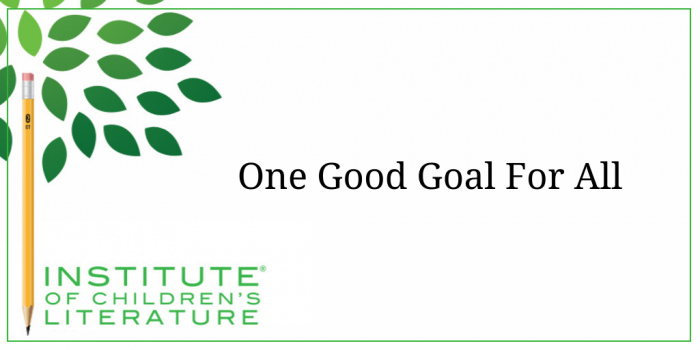1000 N. West Street #1200, Wilmington, DE 19801
© 2024 Direct Learning Systems, Inc. All rights reserved.

Much of the time, when we come up with our goals connected to writing, they involve writing a certain number of words, completing a project, or submitting material. But there is one goal that should be on everyone’s list, and that’s studying and improving our craft. Almost all goals are helped along when we work on that one. We sell more. We complete more projects. We write more words. We improve our revision quality. All of these come more easily and more effectively when we improve our craftsmanship.
To improve your craftsmanship, you need to know where you are right now. For many, correctly identifying our own strengths and weaknesses can be difficult. And a solid critical assessment of where your study efforts are best expended can be incredibly valuable. So how do we find out what we need to improve?
One excellent way to learn where your writing is strong and where it is weak is to seek out outside help. Critique groups, critique partners, book loving readers, and paid consultations are all valuable to learning where your strengths lie and where your weaknesses are holding you back. This is a new way to look at critiques.

If this is a critique group or critique partner, you might even want to offer the person guidelines listing all the possible items (pacing, plot, voice, etc) and a scale of 1 to 5 (or 1 to 10) with low numbers showing places you need to work to improve something and high numbers reflecting things you show strong skills in. This kind of feedback can help you target specific skills and improve your writing of everything, not just one piece.
Some of us do much of our writing journey on our own. I firmly believe that getting feedback from others is invaluable, and I’ve often been awakened to weaknesses I didn’t know I had by outside input. But you can sniff out some of your problems on your own by a few indicators. One is in your behavior and one is in the results.

Another way to find your weak spots is a quick analysis of a piece of your work. Use colored highlighters to mark different sections so you end up with a visual assessment of your work. In fiction, you might use yellow for all dialogue. Pink for description. Blue for action. Green for transitions (moving us ahead in time or moving us to another setting). Then take two colors of ink pen and circle verbs with one and nouns with another.
After you’ve done all this, look at how well you’ve balanced action and dialogue, and how often you’ve woven them together. Another issue I’ve seen with beginning work is a tendency to do description in blobs, then stop entirely to do dialogue, then stop all conversation to give a blob of action. But in a good story, as in life, we are seeing and speaking and doing things, often all at the same time. On our way into a grocery, we spot a friend and notice she’s colored her hair and we say, “I love the new color.” Or perhaps we choose not to remark on the unfortunate shade of poo yellow. But all these actions, words, and sights are going on together. And they should weave in and out of one another in your writing as well. So your visual study should show that paragraphs are a mix of elements.

If you want to learn if you have issues with flow and clarity and general strength of prose, then consider recording yourself reading your work aloud and playing it back. Then you can truly hear how the work sounds. Judging with your ears can help you find weaknesses you might miss through silent reading. And anything that sounds wrong points to an area where you might strengthen your craft.
Once you have identified your weaknesses, then you can set your craft goals for the year. Exactly how you approach those goals will also depend on what you can afford and how you best learn. Writing classes can be fantastic and distance learning classes can enable you to fit the instruction into your busy life. Coming into the class knowing what kinds of things are your weakness can help you ask your instructor pointed questions about these areas. Other instruction options can include workshops at writing conferences or those done by Highlights Foundation. Workshops are often very focused on specific elements and you may find one that specifically matches the area you need to improve.

Then I pursue them exactly as if they are a class. I either do exercises that come with the books, or I come up with my own to practice what I’ve learned as I move chapter by chapter through the work. I also make it a point to read the books used as examples. It is amazing how much you can learn and improve from a “course” you create for yourself. This can also be a good way to jump start your learning while you are saving up for a pricier option of a class, conference, or workshop.
However you go about pursuing the goal of improving your writing in the coming year, the payoff will be huge. No matter how good we are, we can always be better. So keep craftsmanship on your writing goals for the year. It’ll be worth your time, for sure.
With over 100 books in publication, Jan Fields writes both chapter books for children and mystery novels for adults. She’s also known for a variety of experiences teaching writing, from one session SCBWI events to lengthier Highlights Foundation workshops to these blog posts for the Institute of Children’s Literature. As a former ICL instructor, Jan enjoys equipping writers for success in whatever way she can.
1000 N. West Street #1200, Wilmington, DE 19801
© 2024 Direct Learning Systems, Inc. All rights reserved.
1000 N. West Street #1200, Wilmington, DE 19801
© 2024 Direct Learning Systems, Inc. All rights reserved.
1000 N. West Street #1200, Wilmington, DE 19801
© 2024 Direct Learning Systems, Inc. All rights reserved.
1000 N. West Street #1200, Wilmington, DE 19801
© 2024 Direct Learning Systems, Inc. All rights reserved.

1000 N. West Street #1200, Wilmington, DE 19801
© 2025 Direct Learning Systems, Inc. All rights reserved.

1000 N. West Street #1200, Wilmington, DE 19801
©2025 Direct Learning Systems, Inc. All rights reserved. Privacy Policy.
4 Comments